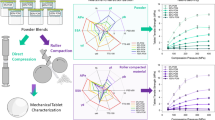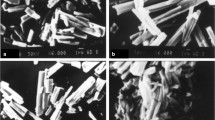Abstract
Purpose
To explain the different tabletability of two structurally similar H1-receptor antihistamine drugs, loratadine (LOR) and desloratadine (DES), based on the molecular basis of bonding area and bonding strength.
Methods
LOR and DES were characterized by powder X-ray diffractometry, thermal analysis, and dynamic water sorption. The compressibility, tabletability, compactibility, and Heckel analysis of their bulk powders and formulations were evaluated. A combined energy framework and topological analysis was used to characterize the crystal structure – mechanical property relationship. Surface energy of bulk powder was assessed by contact angle measurement using the Owens/Wendt theory.
Results
Both LOR and DES bulk powders are phase pure and stable under compaction. The superior tabletability of LOR is attributed to both larger bonding area (BA) and higher interparticle bonding strength (BS). The larger BA of LOR results from its experimentally established higher plasticity, which is explained by the presence of more densely packed molecular layers with smooth surface topology. The higher BS of LOR corresponded to its significantly higher dispersive component of the surface energy.
Conclusions
This work provides new insights into the molecular origins of BA and BS, which can be applied to improve mechanical properties and tableting performance of drugs through appropriate crystal engineering.







Similar content being viewed by others
Abbreviations
- BA:
-
Bonding area
- BS:
-
Bonding strength
- DES:
-
Desloratadine
- DSC:
-
Differential scanning calorimetry
- LOR:
-
Loratadine
- MCC:
-
Microcrystalline cellulose
- OTC:
-
Over-the-counter
- PXRD:
-
Powder X-ray diffractometry
- RH:
-
Relative humidity
- TGA:
-
Thermogravimetric analysis
- P y :
-
Mean yield pressure
- ε:
-
Tablet porosity
- ρ:
-
Tablet density
- ρt :
-
Powder true density
- σ0 :
-
Tensile strength of the tablet at zero porosity
References
Sun CC. Microstructure of tablet—pharmaceutical significance, assessment, and engineering. Pharm Res. 2017;34(5):918–28.
Sun CC. Decoding powder tabletability: roles of particle adhesion and plasticity. J Adhes Sci Technol. 2011;25(4–5):483–99.
Ambros MC, Podczeck F, Podczeck H, Newton JM. The characterization of the mechanical strength of chewable tablets. Pharm Dev Technol. 1998;3(4):509–15.
Bi Y, Sunada H, Yonezawa Y, Danjo K, Otsuka A, Iida K. Preparation and evaluation of a compressed tablet rapidly disintegrating in the oral cavity. Chem Pharm Bull. 1996;44(11):2121–7.
Simons FE, Simons KJ. Histamine and h1-antihistamines: Celebrating a century of progress. J Allergy Clin Immunol. 2011;128(6):1139–1150.e1134.
Simons FE. Advances in h1-antihistamines. N Engl J Med. 2004;351(21):2203–17.
Lieberman P, Hernandez-Trujillo V, Lieberman J, Frew AJ. Antihistamines. In: Rich RR, Fleisher TA, Shearer WT, Schroeder HW, Frew AJ, Weyand CM, editors. Clinical immunology. third ed. Edinburgh: Mosby; 2008. p. 1317–29.
Lemke TL, Williams DA. Foye's principles of medicinal chemistry: Wolters Kluwer health/Lippincott Williams & Wilkins; 2012.
Hilbert J, Radwanski E, Weglein R, Luc V, Perentesis G, Symchowicz S, et al. Pharmacokinetics and dose proportionality of loratadine. J Clin Pharmacol. 1987;27(9):694–8.
Ramanathan R, Reyderman L, Kulmatycki K, Su AD, Alvarez N, Chowdhury SK, et al. Disposition of loratadine in healthy volunteers. Xenobiotica. 2007;37(7):753–69.
Clark MJ, Million RP. Allergic rhinitis: market evolution. Nat Rev Drug Discov. 2009;8(4):271–2.
Trygstad TK, Hansen RA, Wegner SE. Evaluation of product switching after a state medicaid program began covering loratadine otc 1 year after market availability. J Manag Care Pharm. 2006;12(2):108–20.
Glass DJ, Harper AS. Assessing satisfaction with desloratadine and fexofenadine in allergy patients who report dissatisfaction with loratadine. BMC Fam Pract. 2003;4:10.
Geha RS, Meltzer EO. Desloratadine: a new, nonsedating, oral antihistamine. J Allergy Clin Immunol. 2001;107(4):751–62.
Molimard M, Diquet B, Benedetti MS. Comparison of pharmacokinetics and metabolism of desloratadine, fexofenadine, levocetirizine and mizolastine in humans. Fundam Clin Pharmacol. 2004;18(4):399–411.
Ramanathan R, Reyderman L, Su AD, Alvarez N, Chowdhury SK, Alton KB, et al. Disposition of desloratadine in healthy volunteers. Xenobiotica. 2007;37(7):770–87.
Osei-Yeboah F, Chang SY, Sun CC. A critical examination of the phenomenon of bonding area - bonding strength interplay in powder tableting. Pharm Res. 2016;33(5):1126–32.
Reutzel-Edens SM, Bush JK, Magee PA, Stephenson GA, Byrn SR. Anhydrates and hydrates of olanzapine: crystallization, solid-state characterization, and structural relationships. Cryst Growth Des. 2003;3(6):897–907.
Roy S, Quiñones R, Matzger AJ. Structural and physicochemical aspects of dasatinib hydrate and anhydrate phases. Cryst Growth Des. 2012;12(4):2122–6.
Sun C, Grant DJW. Improved tableting properties of p-hydroxybenzoic acid by water of crystallization: a molecular insight. Pharm Res. 2004;21(2):382–6.
Chang S-Y, Sun CC. Superior plasticity and tabletability of theophylline monohydrate. Mol Pharm. 2017;14(6):2047–55.
Grzesiak AL, Lang M, Kim K, Matzger AJ. Comparison of the four anhydrous polymorphs of carbamazepine and the crystal structure of form i. J Pharm Sci. 2003;92(11):2260–71.
Sun C, Grant DJ. Influence of crystal structure on the tableting properties of sulfamerazine polymorphs. Pharm Res. 2001;18(3):274–80.
Bag PP, Chen M, Sun CC, Reddy CM. Direct correlation among crystal structure, mechanical behaviour and tabletability in a trimorphic molecular compound. CrystEngComm. 2012;14(11):3865–7.
Aitipamula S, Wong ABH, Chow PS, Tan RBH. Cocrystallization with flufenamic acid: comparison of physicochemical properties of two pharmaceutical cocrystals. CrystEngComm. 2014;16(26):5793–801.
Liu L, Wang C, Dun J, Chow AHL, Sun CC. Lack of dependence of mechanical properties of baicalein cocrystals on those of the constituent components. CrystEngComm. 2018;20(37):5486–9.
Krishna GR, Shi L, Bag PP, Sun CC, Reddy CM. Correlation among crystal structure, mechanical behavior, and tabletability in the co-crystals of vanillin isomers. Cryst Growth Des. 2015;15(4):1827–32.
Sun CC, Hou H. Improving mechanical properties of caffeine and methyl gallate crystals by cocrystallization. Cryst Growth Des. 2008;8(5):1575–9.
Mannava MKC, Suresh K, Nangia A. Enhanced bioavailability in the oxalate salt of the anti-tuberculosis drug ethionamide. Cryst Growth Des. 2016;16(3):1591–8.
Suresh K, Nangia A. Lornoxicam salts: crystal structures, conformations, and solubility. Cryst Growth Des. 2014;14(6):2945–53.
Fell JT, Newton JM. Determination of tablet strength by the diametral-compression test. J Pharm Sci. 1970;59(5):688–91.
Joiris E, Martino PD, Berneron C, Guyot-Hermann A-M, Guyot J-C. Compression behavior of orthorhombic paracetamol. Pharm Res. 1998;15(7):1122–30.
Khomane KS, More PK, Raghavendra G, Bansal AK. Molecular understanding of the compaction behavior of indomethacin polymorphs. Mol Pharm. 2013;10(2):631–9.
Yadav JPA, Bansal AK, Jain S. Molecular understanding and implication of structural integrity in the deformation behavior of binary drug–drug eutectic systems. Mol Pharm. 2018;15(5):1917–27.
Heckel RW. An analysis of powder compaction phenomena. Trans Metall Soc AIME. 1961;221:1001–8.
Heckel RW. Density-pressure relationships in powder compaction. Trans Metall Soc AIME. 1961;221:671–5.
Kuentz M, Leuenberger H. Pressure susceptibility of polymer tablets as a critical property: a modified heckel equation. J Pharm Sci. 1999;88(2):174–9.
Paul S, Sun CC. The suitability of common compressibility equations for characterizing plasticity of diverse powders. Int J Pharm. 2017;532(1):124–30.
Owens DK, Wendt RC. Estimation of the surface free energy of polymers. J Appl Polym. 1969;13(8):1741–7.
Srirambhatla VK, Guo R, Dawson DM, Price SL, Florence AJ. Reversible, two-step single-crystal to single-crystal phase transitions between desloratadine forms I, II, and III. Cryst Growth Des. 2020;20(3):1800–10.
Woollam GR, Neumann MA, Wagner T, Davey RJ. The importance of configurational disorder in crystal structure prediction: the case of loratadine. Faraday Discuss. 2018;211(0):209–34.
Bryant MJ, Maloney AGP, Sykes RA. Predicting mechanical properties of crystalline materials through topological analysis. CrystEngComm. 2018;20(19):2698–704.
Turner MJ, McKinnon JJ, Wolff SK, Grimwood DJ, Spackman PR, Jayatilaka D and Spackman MA. Crystalexplorer17. In: University of Western Australia; 2017.
Turner MJ, Grabowsky S, Jayatilaka D, Spackman MA. Accurate and efficient model energies for exploring intermolecular interactions in molecular crystals. J Phys Chem Lett. 2014;5(24):4249–55.
Turner MJ, Thomas SP, Shi MW, Jayatilaka D, Spackman MA. Energy frameworks: insights into interaction anisotropy and the mechanical properties of molecular crystals. Chem Commun. 2015;51(18):3735–8.
Bhatt PM, Desiraju GR. Form i of desloratadine, a tricyclic antihistamine. Acta Crystallogr C. 2006;62(6):o362–3.
Kaminski JJ, Carruthers NI, Wong S-C, Chan T-M, Motassim Billah M, Tozzi S, et al. Conformational considerations in the design of dual antagonists of platelet-activating factor (paf) and histamine. Bioorg Med Chem. 1999;7(7):1413–23.
Popovic G, Cakar M, Agbaba D. Acid-base equilibria and solubility of loratadine and desloratadine in water and micellar media. J Pharm Biomed Anal. 2009;49(1):42–7.
Sun CC. A material-sparing method for simultaneous determination of true density and powder compaction properties--aspartame as an example. Int J Pharm. 2006;326(1–2):94–9.
Wang C, Sun CC. Identifying slip planes in organic polymorphs by combined energy framework calculations and topology analysis. Cryst Growth Des. 2018;18(3):1909–16.
Singaraju AB, Nguyen K, Gawedzki P, Herald F, Meyer G, Wentworth D, et al. Combining crystal structure and interaction topology for interpreting functional molecular solids: a study of theophylline cocrystals. Cryst Growth Des. 2017;17(12):6741–51.
Joshi TV, Singaraju AB, Shah HS, Morris KR, Stevens LL, Haware RV. Structure–mechanics and compressibility profile study of flufenamic acid:Nicotinamide cocrystal. Cryst Growth Des. 2018;18(10):5853–65.
Wang C, Sun CC. Computational techniques for predicting mechanical properties of organic crystals: a systematic evaluation. Mol Pharm. 2019;16(4):1732–41.
Fichtner F, Mahlin D, Welch K, Gaisford S, Alderborn G. Effect of surface energy on powder compactibility. Pharm Res. 2008;25(12):2750–9.
Sun CC. Role of surface free energy in powder behavior and tablet strength. In: Mittal K, Etzler F, editors. Adhesion science: Applications to pharmaceutical, medical and dental fields: Scrivener Publishing /John Wiley & Sons; 2017. p. 75–88.
Du Y, Xu J, Sakizadeh JD, Weiblen DG, McCormick AV, Francis LF. Modulus- and surface-energy-tunable thiol–ene for uv micromolding of coatings. ACS Appl Mater Interfaces. 2017;9(29):24976–86.
Hiestand EN. Dispersion forces and plastic deformation in tablet bond. J Pharm Sci. 1985;74(7):768–70.
Steiner T. R. Desiraju G. distinction between the weak hydrogen bond and the van der waals interaction. Chem Commun. 1998;8:891–2.
Luangtana-Anan M, Fell JT. Bonding mechanisms in tabletting. Int J Pharm. 1990;60(3):197–202.
Aakeröy CB, Seddon KR. The hydrogen bond and crystal engineering. Chem Soc Rev. 1993;22(6):397–407.
Desiraju GR. Crystal engineering: from molecule to crystal. J Am Chem Soc. 2013;135(27):9952–67.
Vishweshwar P, McMahon JA, Bis JA, Zaworotko MJ. Pharmaceutical co-crystals. J Pharm Sci. 2006;95(3):499–516.
ACKNOWLEDGMENTS AND DISCLOSURES
We thank the Minnesota Supercomputing Institute (MSI) at the University of Minnesota for providing the resources that contributed to the research results reported within this paper (http://www.msi.umn.edu).
Author information
Authors and Affiliations
Corresponding author
Additional information
Publisher’s Note
Springer Nature remains neutral with regard to jurisdictional claims in published maps and institutional affiliations.
Electronic supplementary material
ESM 1
(DOCX 12197 kb)
Rights and permissions
About this article
Cite this article
Shi, Z., Wang, C. & Sun, C.C. Molecular Origin of the Distinct Tabletability of Loratadine and Desloratadine: Role of the Bonding Area – Bonding Strength Interplay. Pharm Res 37, 133 (2020). https://doi.org/10.1007/s11095-020-02856-2
Received:
Accepted:
Published:
DOI: https://doi.org/10.1007/s11095-020-02856-2




